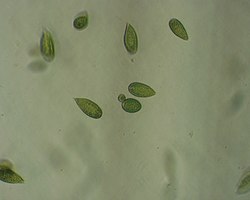| Raphidomonads | |
|---|---|
 | |
| Gonyostomum semen | |
| Scientific classification | |
| Domain: | Eukaryota |
| Clade: | Sar |
| Clade: | Stramenopiles |
| Phylum: | Ochrophyta |
| Clade: | Chrysista |
| Superclass: | Raphidoistia Cavalier-Smith 1986 orth. mut. 2006 |
| Class: | Raphidomonadea Chadefaud 1950 ex Silva 1980 |
| Orders | |
Raphidomonadea is a class of Stramenopiles containing both photosynthetic and phagotrophic protists. The phagotrophic groups are known as Raphopoda, and comprise actinophryid heliozoa and the marine genus Commation . The photosynthetic groups are known as the raphidophyte algae. Their relationship was elucidated through phylogenetic analyses. [1] [2]